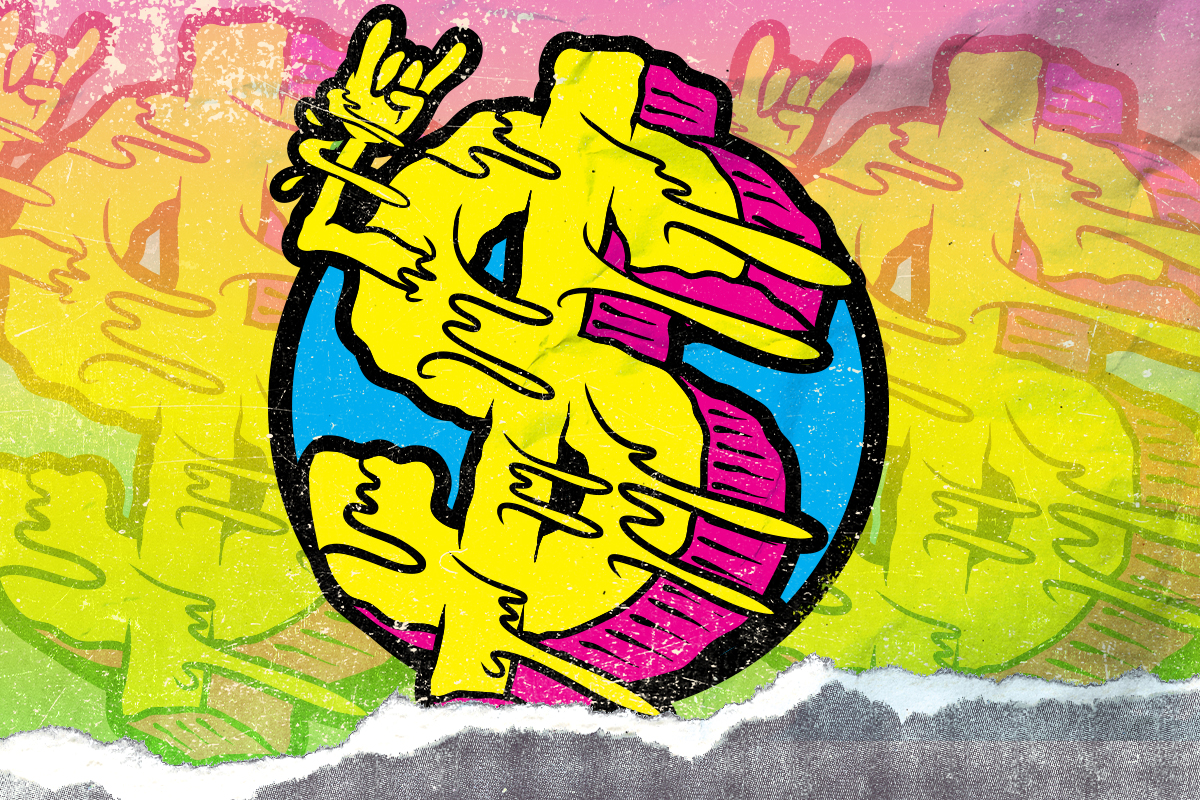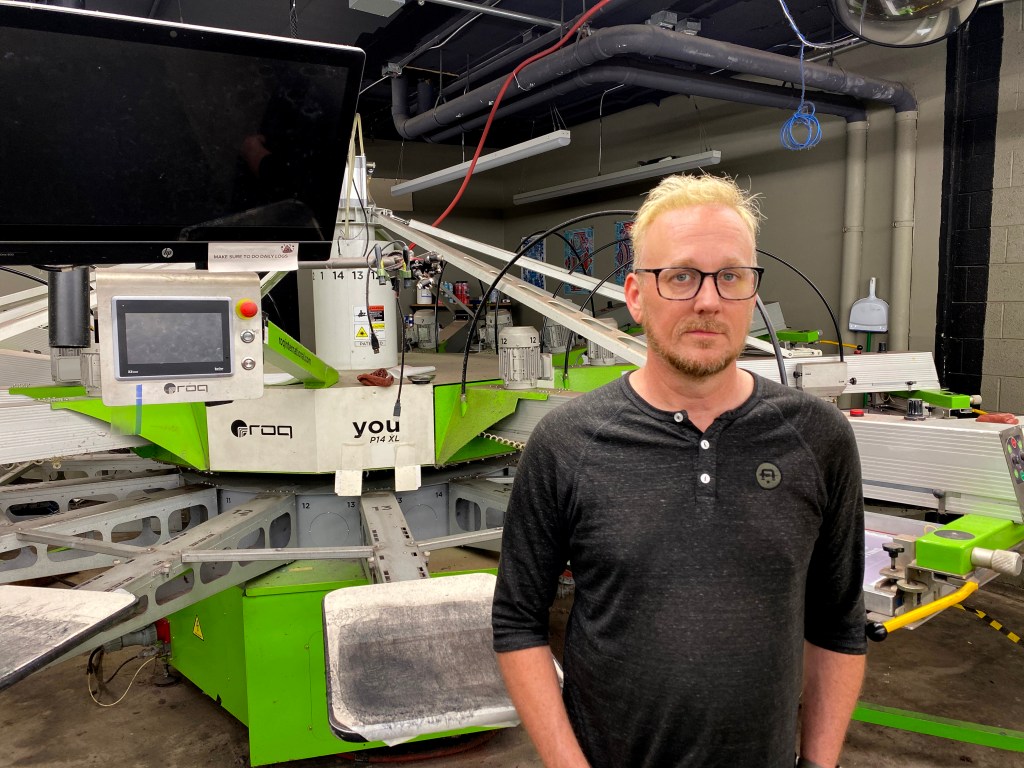
Illustration by Eric-John Torres

Audio By Carbonatix
Dan Hargest has spent 25 years building Acme Prints into a fixture of Phoenix’s indie scene. The Roosevelt-area shop survived the financial crisis of 2008. It survived the pandemic shutdowns.
But this year, Donald Trump’s tariffs and hiccuping economy have brought a different kind of hurt. Bleeding red ink, Hargest last week laid off two of his 18 employees. Those were the first layoffs since Hargest started the business “on his back porch” in 1999.
“It was very painful,” he says inside Acme. Down a hallway of the former cold-storage warehouse, two walls are lined with a patchwork of thank-you letters noting past charitable donations. “When I think about how the other people feel,” he says, “it’s just agonizing.”
Hargest’s roots in Phoenix’s music community run deep. Before he launched Acme, he fronted Pollen, the Arizona-based power-pop/alt-punk band that toured with Less Than Jake and shared stages with Weezer. Today, musicians, tour managers and indie record stores of all stripes rely on his shop for T-shirts, hoodies, embroidered caps, patches, posters, stickers, and other custom merch. And like many in Phoenix’s independent community, he’s increasingly worried about what his business is up against.
This year, make your gift count –
Invest in local news that matters.
Our work is funded by readers like you who make voluntary gifts because they value our work and want to see it continue. Make a contribution today to help us reach our $30,000 goal!
“I’ve never seen such a drop-off in orders as I have this year,” Hargest says. “Every screen-printing company I talk to is affected the same way. This has been an existential threat to their survival.”
Economists see the trend Hargest describes as a widening wave afflicting industries that rely on imported goods. The financial hardship doesn’t come so much from slow orders or late payments. Rather, a sudden spike in import costs and paperwork brought on by the Trump administration’s tariffs are crippling businesses too small to curry favor with the president directly. In some cases, duties have more than doubled, and the president’s capricious — and, pending a Supreme Court decision, potentially illegal — rule changes have made doing business even harder.
Economists and business owners say the administration’s tariff policies are accelerating financial strain. For many local entrepreneurs, the effects are immediate and increasingly difficult to absorb.

Maria Sagan
When policy hits the ground
Since the tariffs were put in place this year, small music businesses across Phoenix, Tempe, Mesa, and beyond — screen printers, record stores, merch managers, gear retailers and others — describe the same pattern: shrinking margins, slower orders, and rising uncertainty.
It is not a desert mirage.
“The prices of imported goods have risen,” says Domenico Ferraro, an associate professor of economics at Arizona State University. “Perhaps not as fast or as much as one might have anticipated, but the price effects are there.”
On November 5, 2025, the Supreme Court heard oral arguments in the consolidated case Learning Resources, Inc. v. Trump. The key question is whether the International Emergency Economic Powers Act (IEEPA) grants the president authority to impose sweeping tariffs, a power the Constitution delegates to Congress.
Trump’s team argued to the justices that the state of the American economy was, in effect, an emergency that could be addressed only by levying huge taxes on imports. Legal scholars noted that even this Supreme Court — which has repeatedly expanded presidential authority in cases connected to Trump’s agenda — appeared skeptical of the administration’s argument.
A decision is expected in early 2026. Until the Court rules, tariff levels can shift with little warning, leaving importers saying the uncertainty makes it almost impossible to plan ahead.
“Volatility has become its own cost,” Hargest says. “We’ve had jobs where the tariffs changed between the day we quoted and the day we paid. We lost money on that order.”
Hargest says the hardest hit items are artist-to-fan accessories such as enamel pins, patches, and keychains.
“Nobody even tries to make that stuff here,” he says. “We’ve printed for ‘Jimmy Kimmel Live!’ for over a decade, and Jimmy is very made-in-USA oriented. Once, they wanted a hat with a woven patch, so we did a deep dive and spent an incredible number of hours researching companies that claimed to manufacture in the U.S. and never found one that actually did. They were all just saying it or importing from somewhere else. There are products where you simply don’t have a domestic option, and even when you think you do, you’re crossing your fingers that it’s real.”
That added stress doesn’t end with T-shirts, pins and keychains. It moves through warehouses, into vans, into clubs, and onto the merch tables where managers like Bryan Sandell are trying to make the new math work.

Bryan Sandell
The road’s new reality
Sandell grew up in a musical household. His father, a classical guitarist turned executive in the musical-instrument business, with stops at Fender and Yamaha. The family spent stretches in Germany and England for his father’s work, giving Sandell an early sense of how the music industry operates beyond the States. Now, as the owner of Tempe-based 1212 Management, he sees the effects of the tariffs up close.
“[Tariffs are] chiseling away at our profits,” says Sandell. “I’m trying not to pass that cost along and just treating it as the cost of doing business.”
He’s speaking from his headquarters, a mid-century ranch house in Tempe’s Maple-Ash neighborhood that once doubled as a live-radio venue, hosting musicians such as Arizona indie-pop artist Zella Day. Recent changes in music, along with tariffs, have had him considering selling the space altogether to stay ahead of uncertainty.
Having spent years on the road himself as well as managing Authority Zero, The Expendables, Ballyhoo!, and Jason DeVore, and road-managing Rebelution to ScHoolboy Q and Goldfinger, he sees the pressure affecting not just the business, but artists, too.
“It’s hard to plan tours because we’re so dependent on backends, and ticket sales have been soft,” he says. “You hear about artists having mental breakdowns because of the financial stress.”
There is good evidence that stress has been increasing for professional musicians in recent years. A 2023 survey by Help Musicians and the Musicians’ Union in the UK found nearly one in three professional musicians reported low mental well-being tied to financial instability and touring stress. A 2025 report by Chartmetric, the global music analytics firm, captures the structural side of the problem. Since 2022, the share of artists who are touring has sharply fallen — mid-level acts from 19 to 12 percent, top-tier acts from 44 to 36 percent. Sluggish ticket sales are a major reason, exposing a deeper fault line in the music economy, where the risks of touring are increasingly outweighing the rewards.
That same uncertainty shows up in the merch business. Sandell says his costs have spiked this year. A blank hat that cost $5.50 in early 2025 now runs $6.27 — a 14 percent jump in just a few months. That increase ripples through printing, packaging, and shipping, pushing retail T-shirt prices from $25 toward $30.
“Nobody wants to be the first band charging $35 for a T-shirt,” Sandell says, regarding those aforementioned mid-level band stats. “But it’s heading there.”

Jacob Tyler Dunn
Behind the counter
Kimber Lanning, founder of Stinkweeds Records and a longtime advocate through the Alliance of Independent Media Stores, says the situation is equally unstable for music retailers.
Lanning opened her shop in 1987, settling most recently just a few blocks from Melrose. Her colorful and tidy store — with rack upon rack of vinyl, plus T-shirts, cassettes, and other curios — has long been a gathering place for the area’s indie scene. Elliott Smith, Sleater-Kinney, Blonde Redhead, My Morning Jacket and others have performed there. The building itself, to which she added a second story less than two years ago, carries its own history: It once housed a private library for the far-right and anti-communist John Birch Society. Yet beneath the tidy surface of a shop housed in what was once a temple to low-tax, limited-government “Americanism,” a business-hostile reality is emerging as shipping carriers unleash what Lanning calls “flat-fee chaos.”
“UPS and FedEx are charging arbitrary import surcharges,” she says. “No transparency, no phone calls returned. People are refusing shipments because the fees are higher than the product value.”
Attempts to source products domestically offer little relief, even in American-made stereo gear. “Yes, you can buy a handmade U.S. turntable — for ten grand,” Lanning says. “But the days of a reliable $250 model are gone. We abandoned that industry in the ’80s, and you can’t rebuild that overnight.” (Most U.S. turntable makers folded or shifted production overseas as CDs, introduced in 1982, quickly overtook vinyl.)
For Stephen Chilton, who promotes concerts under Psycho Steve Presents, tariff pain shows up in the infrastructure that makes live music possible. “A decent midsize club probably has a million dollars in sound and lights,” Chilton says. “If you slap a hundred-percent tariff on that gear, that’s a giant number.”
He says the problem isn’t just daily operations but the long-term risk for new venues. “You can’t plan a build-out if you don’t know what equipment will cost in a year,” he says.
Chilton also sees growing visa obstacles for international artists. “Agents I know are telling British and Latin artists just to skip the U.S. next year,” he says. “If 20 percent of foreign acts stay home, that’s a huge hit. But it’s invisible because you don’t see the tour that never got booked.”
Audiences, he adds, are spending differently, splurging on fewer nights out as tour costs rise. “When someone drops $400 on a Taylor Swift ticket, they’re not going to a $25 club show the next week,” he says.
Yet not every small entrepreneur is feeling the pinch this year. Ed Sokol, who owns Black Mountain Guitar and Mad Hatter Guitar Products in Cave Creek, says his customer base — largely affluent, older, and enjoying a 10 percent year-to-date Dow Jones swell — has remained stable.
“A Boss pedal going up 20 percent doesn’t faze them,” Sokol says. “Most of my customers are retired and living off investments. When interest rates rose, they made more money.”
Sokol’s inventory is mostly U.S.-made, including Gibson, Fender, and PRS. He says his sales fluctuate more with the stock market than with trade policy. “When the Dow drops, then I feel it,” he says.
The cost of protectionism
Economists have been bearish on tariffs for decades. A recent University of Chicago Booth IGM survey of leading economists found that nearly 90 percent agreed tariffs harm domestic consumers more than they help producers. The researchers found that import duties act as a hidden tax at every stage of production, raising the cost of raw materials, components, and finished goods alike.
The Peterson Institute for International Economics, established by the late billionaire investment banker and former U.S. Commerce Secretary Pete Peterson, reached a similar conclusion in a 2025 report. Economists there found that while higher tariffs may yield short-term revenue gains, the broader effect is slower growth, fewer jobs, and lasting damage to the small enterprises that make up much of the real economy.
For his part, ASU’s Ferraro likewise cautions against conflating a strong stock market with a healthy economy. “A common mistake is to look at a booming stock market and conclude tariffs haven’t been harmful,” he says. “That’s not necessarily true. The apparent strength may be driven by massive investments in artificial intelligence and data centers that are masking the negative effects.”
“At the end of the day,” he adds, “when you consider the detrimental effects, I always conclude tariffs are not the right tool to achieve the stated objectives. They end up slowing the economy and harming the labor market.”
Still, the policy remains useful — politically, at least. In August 2025, the White House reinstated broad tariffs under Section 301 of the Trade Act, framing the move as a bold reshoring effort: a way to advantage American manufacturers in a globalized marketplace. That message plays well, even if its economic payoff remains doubtful.
“The administration believes the United States has been treated unfairly by trading partners,” Ferraro says. “And because of the rising federal deficit, tariffs are seen as a way to raise revenue. Those are the standard arguments in support of trade policy of this kind.”
But these new rules provide far fewer exemptions for small creative sectors such as music merch, audio gear, and boutique instruments and electronics that depend on intricate global supply chains.
Additionally, the suspension of the long-standing de minimis customs rule — which once allowed low-value shipments under $800 to enter the country duty-free — has blown yet another headwind toward small creative businesses. Goods that once moved across borders with a few clicks now face full tariffs and customs holds. For print shops, record stores, and gear retailers, those frictions add up, turning a $200 shipment into a $350 gamble and further squeezing already thin margins.
“It’s another mouth at the table to feed,” Sandell says. “Someone’s going to get paid. It just isn’t us.”
For musicians, the economics are inseparable from the art. Touring, once a rite of passage, has become a perilous accounting exercise. Sandell says that for many artists, the financial math drives creative choices. “We used to plan a tour to promote the record,” he says. “Now we make a record to justify the tour.”
For small businesses, the toll is financial and personal. Sandell says several younger artists have postponed touring altogether. “You can’t tell a 25-year-old musician to front thousands in merch inventory when shipping costs are unpredictable,” he says. “They’d rather stay home and livestream.”

Meagan Mastriani
The cost to culture
Phoenix is no stranger to bouts of cultural desolation, and it’s those small businesses and creative communities whose collective Herculean shoulders have allowed Phoenix to achieve destination status.
Back at Stinkweeds, Lanning worries about the cultural fallout if those ventures fail.
“When shipping companies, trade policy and inflation all hit at once, it’s not just about margins. It’s about who survives,” she says. “Independent stores are the connective tissue of a music scene. If they go, the scene goes.”
The irony, several interviewees note, is that the industries being squeezed once symbolized American self-reliance. Merch tables, record stores and indie venues have long served as miniature manufacturing and export hubs that design, fabricate and distribute culture worldwide. (What, after all, could be more American than rock ‘n’ roll and advertising?)
The ripple effects of tariffs are turning those creative pipelines into choke points. The Valley’s working artists and small shops can’t bear the brunt of messy international trade policy indefinitely.
The economics of the music scene have always been fraught. When businesses or bands or venues disappear, there’s no guarantee they’ll return. Says Chilton: “It all comes down to whether people can afford to make art in the first place.”